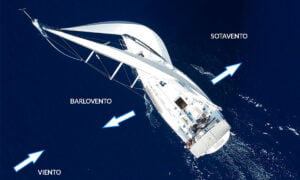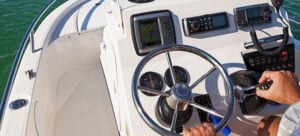To be an expert in navigation you have to acquire endless knowledge. Coastal navigation is difficult for the navigator, as he must constantly remain precisely positioned on the chart. Although today the precision of electronic devices has favored navigation, there are very effective methods to obtain positions with a high degree of accuracy, called position lines.
What are navigation lines?
The first concept that we must be clear about are the navigation lines. They consist of a series of techniques that are applied, in this case to coastal navigation, to ensure that a vessel moves efficiently and safely from its place of origin to its destination.
These techniques consist of drawing lines of the ship's position from notable points on the coast that allow us to glimpse the line on which the ship's position is located. These notable points must meet two characteristics: they must be perfectly visible and identifiable from the sea and they must appear on the nautical chart of the area.
Types of position lines in navigation
There are various types of position lines in coastal navigation. We are going to group them into three large groups:
Straight
This includes lines, delays and markings, among others.
Leading
The concept of leading (not to be confused with opposition) is understood when from the boat we look at the land and two objects (two points) on it are in a line, or what is the same is the line that joins two objects. or marks as it passes through the eye of the observer.
On the chart it corresponds to the line that passes through two points or marks represented on it. It is usually used in the letter to determine the total correction
Opposition
It is the line that joins two points and the observer is on said line and between said points, it is usually used on the chart in addition to as a position line to find out the total correction.
Delays
It is the angle formed between the view of a point on the coast or object and true, magnetic or needle North. It is measured, like directions, using the circular or quadrantal system. Delays can be:
- True bearing (Dv): referred to true north. The formula to obtain it is Dv= Da + Ct
- Magnetic bearing (Dm): referred to magnetic north. The formula to obtain it is Dm = Da + Δ
- Needle bearing (Da): referred to the north of the needle. The formula to obtain it is Da = Dv – Ct
Ct refers to the total correction obtained by adding the magnetic declination (Dm) and the needle deflection (Δ).
The bearings are subject to errors and must take at least two bearings at two points whose angles are wide enough so that the error is minimal.
Curves
Although there are several, we are going to focus on distance.
Distances
They are measured in miles. Distances to points on the coast are usually measured using radar and with the slider the distance between two points can be determined. Another way to find out a distance is to take two or more delays and depending on the results and once located, take the measurement.
Irregular
They are known as isobatic (points of equal probe) or verile. They are the lines that, on nautical charts, join points of equal depth, also called isobatic. These lines can be used to locate oneself on the chart and to follow a safe course without danger. In turn they can be:
- Estimated: based on certain data such as course, speed, sailing time that may or may not coincide with the real time.
- True or real: it is where the ship is actually located. It can be obtained by the intersection of at least two position lines that intersect as perpendicularly as possible.
Concepts and definitions
Obtaining position lines with the needle
Both the leading lines and the oppositions, as well as the distances, are lines that are drawn directly on the chart, so they can be considered true position lines.
Of the position lines indicated in the previous section, only the bearings can be calculated with the needle for subsequent conversion to true and thus be able to plot them on the chart.
Thus, for example, if we are sailing and we want to know the true bearing at a point on the coast we can use a bearing compass and take its reading or if we place the bow of the boat facing that point taking the reading of the needle we will obtain in both cases the delay of needle to that place.
Once obtained, to convert it to true we will have to use the values of the updated magnetic declination and use the value of the deviation depending on the course being navigated. Once all this data is obtained, we will apply the formulas:
Ct = dm + Δ
Dv = Da + Ct
Once the Dv is obtained, it can be drawn on the chart and thus obtain a position line.
To plot it, the first thing is, once the needle has been measured and as we have indicated previously, convert it to true, so for example if we measure a Da to Punta Almina of 175º with an updated dm of 5ºNW and a deviation of 1ºNW we will obtain a Dv equal to:
Ct = dm + Δ = – 5 + (-1) = – 6º
Dv = Da + Ct = 175 + (- 6) = 169º
Once calculated, since we do not know the exact point where we are, we will have to use as a reference the point where we are taking said delay, in the case of the Punta Almina example. If we place an observer at the point from where we take the bearing, he will have a totally opposite bearing with respect to us, that is, if we see the observer on the ground with a bearing of 169º, he will be seeing us with an opposite bearing, that is, 169 + 180 = 349º, which is what we will draw.
Once drawn, if we place ourselves at any of the points on the position line (we can be at any of them) we can verify that the Dv is indeed 169º.
There are other less orthodox but more practical methods to trace them, such as taking the measurement directly without having to calculate the opposite and passing the point through the place where the measurement is taken and prolonging it, or also placing the protractor inverted.
Use of leading lines, bearings and probes as safety position lines
When we navigate, it is very common to use fixed land lines to mark the entrances to ports or the deepest parts of a channel. These lines can be artificial, that is, created for such purposes, or natural such as church towers, mountain peaks, recognizable buildings, etc.
Delays are also used in coastal navigation to avoid any danger or pitfall in shallow waters, just as following the veriles (points of the same depth) aided by the probe alarm provides us with a means of safe navigation, this being a very advisable method when sailing near the coast in fog.
Conditions that must be met for position lines to be reliable
When drawing a position line, several conditions must meet for it to have a certain reliability, one of the most important being measurement:
- The angle of cut of two position lines should be as close as possible to a right angle.
- When taking delays, the boat must be as stationary as possible.
- The distances taken with the radar must take into account their reliability and that this be taken at the desired point (lighthouse, buoy...) and not in an echo coming from further inland.
- Land points must be clearly recognizable to be able to place them on the chart.
- In the lines the distance must be less than that between the points of the line. Finally, special attention must be paid to the layout on the letter.
If you are still wanting to learn more about navigation and everything that it entails, you can consult some of our pleasure boat skipper courses. At Anclademia we advise you and accompany you throughout the entire process so that you can obtain your navigation license.





